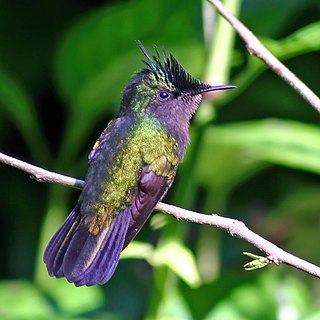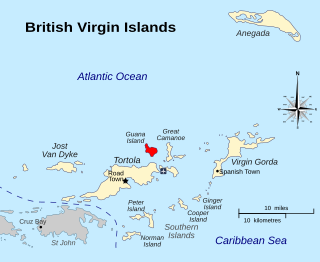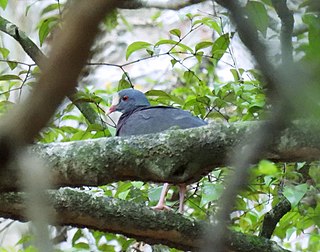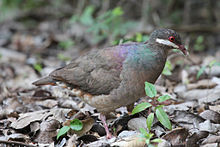
The common ground dove is a small bird that inhabits the southern United States, parts of Central America, the Caribbean and northern South America. It is considered to be the smallest dove that inhabits the United States. As its name suggests, the bird spends the majority of its time on the ground walking but still has the ability to fly.

The Puerto Rican woodpecker is the only woodpecker endemic to the archipelago of Puerto Rico and is one of the five species of the genus Melanerpes that occur in the Antilles. Furthermore, it is the only resident species of the family Picidae in Puerto Rico. The species is common on the main island of Puerto Rico and rare on the island of Vieques.

The fauna of Puerto Rico is similar to other island archipelago faunas, with high endemism, and low, skewed taxonomic diversity. Bats are the only extant native terrestrial mammals in Puerto Rico. All other terrestrial mammals in the area were introduced by humans, and include species such as cats, goats, sheep, the small Indian mongoose, and escaped monkeys. Marine mammals include dolphins, manatees, and whales. Of the 349 bird species, about 120 breed in the archipelago, and 47.5% are accidental or rare.

The Key West quail-dove is a species of bird from the doves and pigeon family Columbidae. It is probably most closely related to the bridled quail-dove.

The ruddy quail-dove is a species of bird in the dove and pigeon family Columbidae. It breeds throughout the West Indies, Central America, and tropical South America. It has appeared as a vagrant in Florida and southern Texas. It lays two buff-colored eggs on a flimsy platform built on a shrub. Some nests are built on the ground.

The scaly-naped pigeon, also known as the red-necked pigeon, is a bird belonging to the family Columbidae. The species occurs throughout the Caribbean.

The Antillean crested hummingbird is a species of hummingbird in the family Trochilidae. Found across Anguilla, Antigua and Barbuda, Barbados, Dominica, Grenada, Guadeloupe, Martinique, Montserrat, north-east Puerto Rico, Saba, Saint-Barthélemy, Saint Kitts and Nevis, Saint Lucia, Saint Martin, Saint Vincent and the Grenadines, Sint Eustatius, the British Virgin Islands, the U.S. Virgin Islands, and the Lesser Antilles, while it has also been recorded as a vagrant in Florida, USA.

Geotrygon is a bird genus in the pigeon and dove family (Columbidae). Its members are called quail-doves, and all live in the Neotropics. The species of this genus have ranges from southern Mexico and Central America to the West Indies and South America, with 2 species recorded as occasional vagrants reported in Texas and Florida in the United States. Quail-doves are ground-dwelling pigeons that live, nest, and feed in dense forests. They are remarkable for their vivid coloration with light-and-dark facial markings.

The grey-fronted quail-dove is a species of bird in the family Columbidae. It is endemic to Cuba.

The crested quail-dove is a species of bird in the family Columbidae. It is endemic to Jamaica.

The violaceous quail-dove is a species of bird in the family Columbidae. It is found in Argentina, Bolivia, Brazil, Colombia, Costa Rica, Guyana, Nicaragua, Panama, Paraguay, Peru, Suriname, and Venezuela.

Guana Island is an island of the British Virgin Islands (BVI) in the Caribbean. One of the few remaining privately owned islands in its part of the world, Guana has seven white powder-sand beaches and 850 acres (3.4 km2) of tropical forest, mountains, hills, and valleys. The island is mostly natural preserve and has a small resort.

The white-fronted quail-dove is a species of bird in the family Columbidae. It is endemic to the Dominican Republic on the Caribbean island of Hispaniola; it is possibly extirpated from Haiti.

The British Virgin Islands dwarf sphaero, Virgin Gorda least gecko, or Virgin Islands dwarf gecko is a species of gecko and also one of the smallest terrestrial vertebrates. It has only been found on three of the British Virgin Islands: Virgin Gorda, Tortola, and Moskito Island. It was discovered in 1964 and is suspected to be a close relative of Sphaerodactylus nicholsi, a dwarf sphaero from the nearby island of Puerto Rico. It shares its range with the big-scaled least gecko (S. macrolepis), which is found in leaf litter. Unlike this larger gecko, the Virgin Islands dwarf sphaero lives on drier hillsides, yet prefers moist microhabitats found under rocks because it lacks the adaptations necessary for preventing water loss, which is a significant problem due to its small body size.

Sphaerodactylus macrolepis, also known as the big-scaled dwarf gecko or the big-scaled least gecko, is a lizard of the Sphaerodactylus genus. It was first documented in 1859 in the US Virgin Islands, specifically, St. Croix. This diurnal species has since been spotted in other locations such as Puerto Rico with major populations in Culebra.

The purple quail-dove is a species of bird in the family Columbidae. It is found in Colombia and Ecuador.

The Puerto Rican quail-dove is an extinct species of dove from the genus of quail-doves Geotrygon. It is only known by subfossil material from the Holocene of Puerto Rico.



















